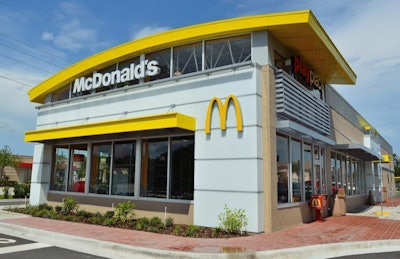
McDonald’s has revealed a broiler welfare commitment that will involve 70 percent of its global broiler supply chain.
The company, on October 27, announced a new broiler welfare policy to be implemented by 2024 in the U.S., Australia, Canada, France, Germany, Italy, Ireland, the Netherlands, Poland, Russia, South Korea, Spain, Switzerland, and the U.K.
Unlike most previous broiler welfare commitments, McDonald’s made no mention of sourcing only broilers according to standards approved by the Global Animal Partnership (GAP) or Royal Society for the Prevention of Cruelty to Animals (RSPCA), but rather as chickens that are raised with "improved welfare outcomes."
About the new policy
The criteria for the new broiler welfare policy are:
- Sourcing chickens for the McDonald’s system that are raised with improved welfare outcomes. The company plans to set targets, measure performance and report on key farm-level welfare outcomes across its largest markets.
- Partnering with technology companies, producers and suppliers to develop on-farm monitoring systems to automate the gathering of key animal health and welfare indicators, including behavioral measures. Once established, these technologies will highlight potential areas for improvement in real time and will be among the first of their kind available at a commercial scale.
- Requiring chickens to be raised in housing environments that promote natural behaviors such as pecking, perching and dust-bathing. These behaviors are encouraged through enrichments, such as the provision of perches and pecking objects, access to floor litter 100 percent of the time, and providing a minimum of 20 lux light intensity during photoperiods, with a minimum of 6 hours of darkness (4 hours to be continuous) during a 24 hour time period, reflecting scientific evidence from poultry experts.
- Conducting commercial trials across select markets in partnership with our largest global chicken suppliers to study the effect that various production parameters have on key welfare outcomes within large-scale, commercial conditions. These trials will measure the effects of inputs such as lighting, stocking density (space allowance) and genetics. This will enable McDonald’s to identify best practices that support improved farm welfare outcomes in specific climates across the globe.
- In the U.S. and Canada, transitioning to sourcing chickens that have been stunned by the use of controlled atmosphere stunning (CAS), a method that is approved by the U.S. Department of Agriculture (USDA) and the Canadian Food Inspection Agency (CFIA). CAS is currently practiced by many approved suppliers for McDonald’s restaurants in Europe and Australia.
- Establishing third party audits to ensure supplier’s farms are in compliance with McDonald’s new and more comprehensive chicken welfare standards.
- Completing an assessment by the end of 2018 to measure the feasibility of extending these commitments to the remaining global markets where McDonald’s operates.
- Establishing a global, multi-stakeholder Advisory Council focused on chicken sustainability, with participation from academics and scientists, suppliers and industry experts, animal welfare and environmental advocates to support our continued journey on chicken sustainability, inclusive of health and welfare.
“Together, we believe these commitments provide the ability to drive and measure continuous improvement for the health and welfare of chickens,” the company stated.
"As one of the world’s largest food companies, we aim to use our scale as an opportunity to achieve impactful change on key societal issues, and we will continue to collaborate with our suppliers, franchisees and employees to achieve real impact.”


















